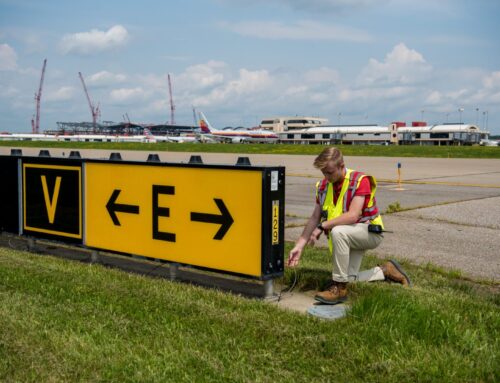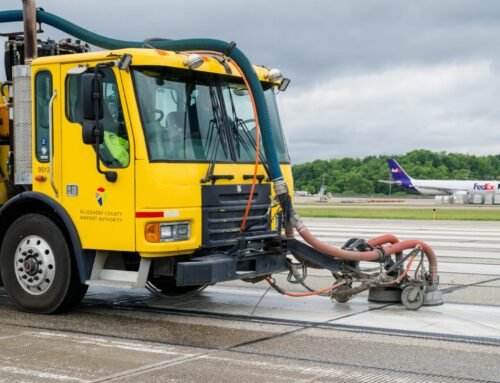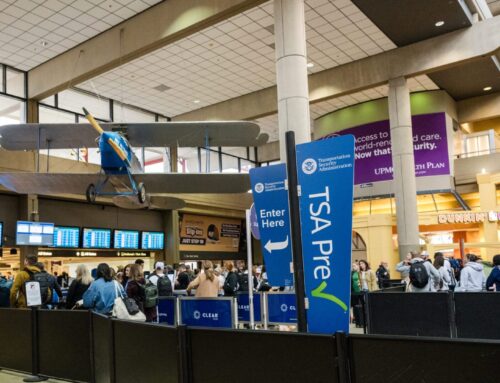Paw Patrol: Meet the K-9 Units That Protect PIT
Officers, canine partners specializing in explosives, narcotics detection based at airport
By Natalie Fiorilli
Published August 24, 2020
Read Time: 4 mins
No two days are the same for the Allegheny County Police Department’s K-9 unit. But there is one constant: it’s never a bad day on the job.
“We work with our dogs, and that’s our best friend,” said K-9 Officer Nathan Dimit. “It’s actually enjoyable going to work because we’re with them.”
Dimit’s partner, K-9 Pedro, a 4-year-old Belgian Malinois, seems to share his enthusiasm.
“As soon as I put my uniform on, he knows it’s time to go,” Dimit said. “He gets excited immediately. Usually, he sneaks upstairs in the middle of the night and he’ll hear my alarm clock go off. Every morning, he’s sitting outside my door waiting for me, it doesn’t matter what time it is.”
Dimit and Pedro are one of five explosive detection teams attached to the Allegheny County Police Department K-9 Unit, which is based at Pittsburgh International Airport. An additional officer and K-9 are assigned to narcotics detection at the airport.
Inseparable partners
The teams working at the airport attend a 12-week training course at the Transportation Security Administration’s National Canine Training Center at Joint Air Force Base San Antonio-Lackland in San Antonio, Texas.
The dogs, provided by the TSA, are usually trained between the ages of 18 months and 2 years old and typically are drawn from seven breeds: Belgian Malinois, German shepherds, Labrador retrievers, German short-haired pointers, vizslas and golden retrievers.
From that point on, the officers and their K-9s are almost inseparable. In fact, most of the airport’s K-9 officers spend more time with their dogs than their spouses and families.

The officers and K-9s participate in a variety of training exercises, practicing their ability to detect explosives through sense of smell. (Photo by Beth Hollerich)
“It’s definitely a strong bond, because you’re with them all the time,” said Officer Chris Ireland.
Ireland joined the airport police department in 2001 and has served as a K-9 Officer for the past 15 years. This summer, Ireland’s longtime partner, Champ, passed away at the age of 11.
In their years of working and living together, Champ was never far from his side.
“He was pretty much 24/7, always there,” Ireland said. “When I got home, he ran the house. He’d be sitting next to me at dinner and when I’d watch TV. He even got mad when I would leave the house and take my kids somewhere without him.”
Now, Officer Ireland is working with a new dog, a 2-year-old black Lab named Block.
Putting in work
Dogs have been a crucial part of securing airports for decades. After a German shepherd named Brandy with the New York Police Department found a bomb on a plane at John F. Kennedy International Airport in 1972, their roles began to expand dramatically.
Now dogs can be found in airports around the world comforting passengers and detecting illegally smuggled goods, among other duties. They may even be part of the solution to slowing the spread of coronavirus.
On the job, the teams patrol the airport, sweeping areas in and around the terminal, including the cargo area and aircraft. Throughout the day, the officers and K-9s also participate in a variety of training exercises, some of which include random, unexpected drills scheduled by the TSA.
The K-9s are trained to detect explosives through their sense of smell and typically alert an officer by sitting.

Officer Scott Shane and K-9 Monty inspect an airplane cabin as part of a regular training exercise. (Photo by Beth Hollerich)
After a K-9 detects the scent, the officer rewards the dog with a toy or a treat, Ireland explained.
“[We treat it like] it’s the best day of their life when they find something, because that’s what they work for. That’s their job,” he said.
And while training is always a part of a K-9 team’s schedule, the officers try to avoid consistency during the work week.
“You don’t want them to be in a routine,” Dimit noted. “You want it to be different every day and to try to change it up for the dog. You don’t want them to know that every time they go in baggage claim and search a bag [during a drill] that they are going to find something. We always try to keep the dog guessing and make sure they don’t get into any habits.”






